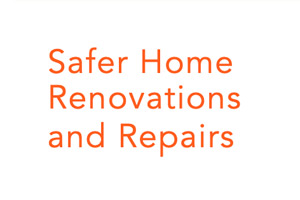Construction dust created during home renovations or remodeling can harm families, so take proper precautions before, during, and after the project.
Before you start, determine if your home as lead-based paint or asbestos:
Some older homes that may have lead-based paint (built before 1978 or before 1960 in New York City) or asbestos (still may be in construction materials like insulation), consider hiring an EPA certified professional to determine if lead or asbestos is present. If lead or asbestos are present, hiring an EPA certified professional to do the work is recommended, since extra precautions are required to safely do the job. This is especially important if you are planning an extensive renovation or if there is significant disrepair.
For repair work not involving lead and asbestos, use these simple steps:
Resources:
Be lead safe! Lead paint was used widely in homes built before 1978 (or before 1960 in New York City) and can still be in the underlayers of paint. Unless environmental testing shows otherwise, assume your paint contains lead and use lead safe work practices.
US Environmental Protection Agency (USEPA): www.epa.gov/lead (to find a certified contractor, click on ““Find a lead-safe certified firm”)
NYS Department of Health (DOH): www.health.ny.gov/environmental/lead/renovation_repair_painting
Asbestos: Asbestos may still be found in a wide range of building materials, regardless of the age (ex: pipe insulation, roofing tiles and shingles, patching compounds). The only way to confirm that the material does not contain asbestos is to have it tested.
USEPA: www.epa.gov/asbestos (to find a certified contractor, click on “Hire an asbestos professional”)
NYS DOH: www.health.ny.gov/environmental/indoors/asbestos/
Choosing safer products: Environmental Working Group (EWG) – Guides on selecting healthier materials for your home (for everyday use, renovations, and home building): www.ewg.org/healthyhomeguide

